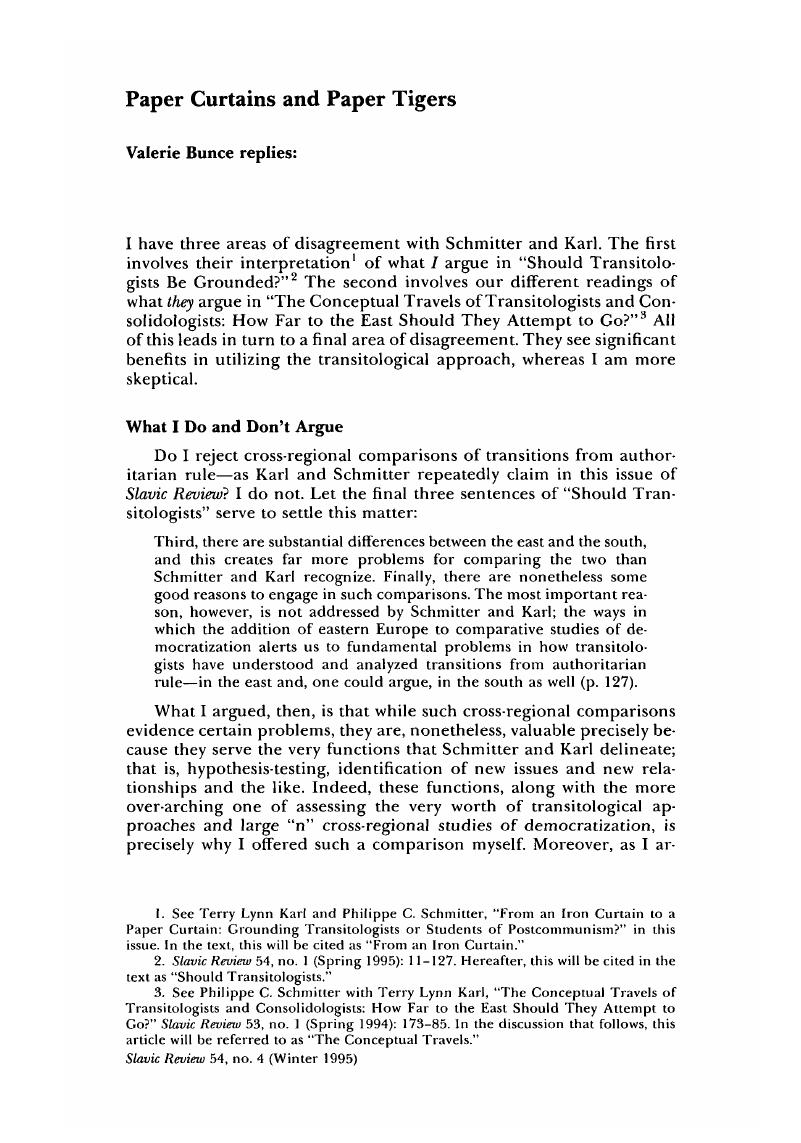Published online by Cambridge University Press: 27 January 2017

1. See Terry Lynn Karl and Philippe C. Schmitter, “From an Iron Curtain to a Paper Curtain: Grounding Transitologists or Students of Postcommunism?” in this issue. In the text, this will be cited as “From an Iron Curtain.“
2. Slavic Review 54, no. 1 (Spring 1995): 11-127. Hereafter, this will be cited in the text as “Should Transitologists.“
3. See Schmitter, Philippe C. with Karl, Terry Lynn, “The Conceptual Travels of Transitologists and Consolidologists: How Far to the East Should They Attempt to Go?” Slavic Review 53, no. 1 (Spring 1994): 173-85.CrossRefGoogle Scholar In the discussion that follows, this article will be referred to as “The Conceptual Travels.“
4. See Bunce, Valerie, Do New Leaders Make a Difference: Executive Succession Under Communism and Capitalism. (Princeton University Press, 1981).CrossRefGoogle Scholar This is why I find Karl and Schmitter's spirited defense of the value of cross-regional comparisons in general and their footnote 9 (“From An Iron Curtain“) to be so puzzling.
5. “Comparing East and South,” Journal of Democracy 6, no. 3 (July 1995): 87-100.
6. Karl and Schmitter, therefore, seem to conflate three issues in their response: cross-regional comparisons in general, large sample cross-regional comparisons dealing with democratization in the south and east and, finally, small sample cross-regional comparisons dealing with democratization in the south and east. My position on each of these three issues varies, as this reply will make clear.
7. This is not to mention another problem—sample selection. As every social scientist knows, the conclusions we draw in our investigations rest heavily on the cases we select—and the cases we leave out. In large sample studies (which are not usually based in fact on sampling), the decisions to exclude some cases and include others can have enormous consequences for the arguments that can be and are made.
8. Indeed, this is why “region” for eastern Europe is less a “cultural construct” waiting to be deconstructed (as Karl and Schmitter argue in “From an Iron Curtain“) than a meaningful summary of an interwoven set of political, economic and social characteristics. By contrast, the diverse histories of countries in Latin America and southern Europe render the category, region, far less meaningful as a summary term.
9. See, for example, Zoran Zic, “Democratic Transition and Self-Determination in Multiethnic Societies: The Different Cases of Spain and the Former Yugoslavia.” Paper presented at the Nineteenth European Studies Conference, University of Nebraska at Omaha, October 5-7, 1994; Hector Schamis, “Reforming the State: The Politics of Privatization in Chile and Britain” (Ph.D. dissertation, Columbia University, 1994).
10. “The Empire Strikes Back: The Transformation of the Eastern Bloc from a Soviet Asset to a Soviet Liability,” International Organization, 39 (Winter 1984/1985), 1-46. Also see my earlier article: “The Political Economy of the Brezhnev Era: The Rise and Fall of Corporatism,” British Journal of Political Science, 13 (January 1983), 129-58.
11. “In Defense of Sovietology,” Post-Soviet Affairs, 3 (1992), 197-238.
12. See Communist Studies and the Social Sciences: Essays on Methodology and Empirical Theory (Chicago: Rand McNally, 1969).
13. There is no definitive way to draw a conclusion as to whether communist area studies was more isolated from the comparative “mainstream” than other area studies. At the very least, however, we cannot answer this question by comparing what was published in Slavic Review versus the Latin American Research Review (see footnote 8 in “From an Iron Curtain“). This is because most of the major debates in the communist field and most of the comparative work done in this field was not published in Slavic Review. Moreover, for a variety of reasons, Slavic Review has tended to focus for the most part on Russia and the Soviet Union and not on eastern Europe.
14. The key term here (which is used several times by Karl and Schmitter in “From an Iron Curtain“) is “a priori.” First, the general tendency among scholars in the field has been to presume some similarities and some differences when comparing east and south, or east and west. Blanket statements about uniqueness, in short, are exceedingly rare. Second, while some established social scientists in the field might argue for uniqueness (such as Kenneth Jowitt—as remarked in footnote 7 in “From an Iron Curtain“), they do so in a bounded way, after making some comparisons and, finally, while using comparative theory in order to pinpoint distinctive characteristics. Finally, my claim that eastern Europe has important differences from Latin America and southern Europe rests on a comparison of the three areas. It is simply incorrect, then, to characterize these arguments as either “a priori” or blanket assertions of uniqueness.
15. See, for instance, footnote 19 in “From an Iron Curtain.“
16. To use phrases, such as the “clan of ex-Sovietologists” (see footnote 6 in “The Conceptual Travels“), does not help.
17. (Baltimore: Johns Hopkins University Press, 1986).
18. One example is cited in footnote 27 in “From an Iron Curtain.” Surely, no one in the postcommunist field needed transitology to learn that elites played an important role—through their divisions and through their eventual acquiescence—in the collapse of state socialism in eastern Europe. Indeed, that well-known fact is one reason why I questioned the utility of drawing clear distinctions between mass mobilization versus pacted transitions.
19. See Stavenhagen, Rodolfo, “Challenging the Nation-State in Latin America.” Journal of International Affairs, 45 (Winter 1992), 421-40.Google Scholar
20. This does not mean, however, that such cases cannot be compared. What I am arguing is that such comparisons must be built around explicit recognition of the differences, as well as the existence of some relatively superficial similarities.
21. This is particularly the case, since other cases of abnormal politics—for example, revolution and reform—have received quite sophisticated theoretical treatment.